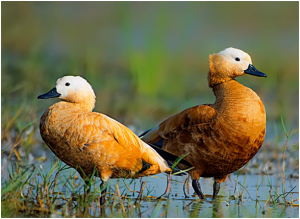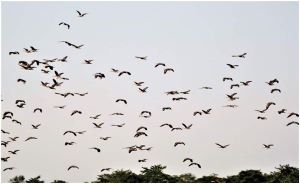
BY DR. RAVINDER PALL SAINI
INDIAN FOREST SERVICE ( RETIRED)
MEMBER, BOARD OF MANAGEMENT,
FOREST RESEARCH UNIVERSITY,
DEHRADUN.
DEHRADUN, 12 OCTOBER 2024:

“Intuitions are like migratory birds, they come without a map without a reason”.
………Amit
World Migratory Bird Day serves as an international call to action for the protection of migratory birds, whose ranges often span into multiple countries, and are facing many different threats worldwide. The annual campaign is organized by the Convention on the Conservation of Migratory Species of Wild Animals (CMS), the African-Eurasian Migratory Waterbird Agreement (AEWA), Environment for the Americas (EFTA), and the East Asian-Australasian Flyway Partnership (EAAFP).

World Migratory Bird Day 2024 will be officially held on 11th May and 12th October. The two days of World Migratory Bird Day reveal the cyclical nature of bird migration as well as the fact that there are varying peak migration periods in the northern and southern hemispheres. Last year the occasion addressed the growing issue of “Water and its importance for Migratory Bird”, as water is most important to life on our planet.
This Year’s Theme:
This year’s World Migratory Bird Day theme, “Protect Insects, Protect Birds” is an opportunity to raise awareness of the importance of insects, to educate, and to learn that how important they are for sustainable migratory birds conservation.

World Migratory Bird Day:
In 2006, the Secretariat of the Agreement on the Conservation of African-Eurasian Migratory Waterbirds (AEWA) along with the Secretariat of the Convention on the Conservation of Migratory Species of Wild Animals (CMS) initiated World Migratory Bird Day.
The Convention on Migratory Species (CMS), also known as the Bonn Convention, is an environmental treaty of the United Nations that supports a worldwide platform for the conservation and ecological use of terrestrial, aquatic, and avian migratory animals and their habitats.

How does Light Pollution affect bird migration?
Alarming Headlines Around The World:
About 35 percent of the world’s wetlands, critical to migratory birds, have been lost in the last 50 years. Utah’s Great Salt Lake, the largest saltwater lake in the Western Hemisphere and used by more than a million shorebirds, is in danger of disappearing within five years. Across the Amur-Heilong Basin in Asia, climate change is amplifying the impact of habitat destruction by depleting natural water systems and depriving migratory birds of vital breeding and stopover site. These sobering examples go together with recent reports that reveal that 48 percent of bird species worldwide are undergoing population declines.

Another poignant example is that of the Aral Sea shared by Kazakhstan and Uzbekistan. Once the fourth-largest lake in the world, it is widely regarded as one of the planet’s worst water-related environmental disasters. Soviet-era irrigation projects almost completely dried up the lake, which led to the loss of livelihoods for fishermen and farmers and the deterioration of public health due to toxic dust and reduced access to clean water. The impact has been severe for the communities around the lake, but also for migratory birds, which lost important food sources and a critically important stopover point on their journey.

Another example is the Sahel, a vast semi-arid region in Africa: Prolonged periods of drought, deforestation, and overgrazing in the Sahel have led to the degradation of the soil and loss of vegetation, threatening the survival of both the local human population and wildlife, including migratory birds. Lake Chad, one of the largest water bodies in Africa in 1960, lost 90 % of its area, depleting water resources for local communities and for many migratory birds. (Source: Convention on the Conservation of Migratory Species of Wild Animals)

What is meant by migratory bird?
Migratory birds are those that fly out to different parts of the world in the winter to escape the cold. The Siberian Crane and Flamingos are examples of migratory birds that flock to India during the winter.

IMPORTANCE OF MIGRATORY BIRDS:
Birds migrating in the world create an amazing phenomenon testifying and signifying their vivid and enormous potentialities of endurance, power, grit, and intelligence. It is a natural phenomenon of birds flying across the world twice a year to reach warmer geographic zones.
Approximately 2000 species of avian fauna migrate every year, generally from colder areas to warmer ones where food and shelter is more congenial, and days are longer. These trips are long, hazardous, and arduous.

Their size is no impediment to their long continent-spanning trips. For example, the ruby-throated hummingbird which weigh only as much as a penny yet can fly about 900 km without a sojourn twice a year across the Gulf of Mexico from the US coast down to the Yucatan Peninsula in Mexico.

Migratory birds have several important roles.
- They are excellent biodiversity indicators, as they reflect the state of our environment.
- By being dependent on different habitats and sites along their migratory routes, trends in their conservation status provide an indication of the state of the natural environment along entire flyways.
- They also act as pest predators, feeding on rodents and potentially harmful insects such as caterpillars, weevils, and cutworms.
- They perform important ecological regulating services: They have a vital role in dispersing seeds and pollinating flowers. For example, grassland birds rely on grasses as nesting habitats and help to maintain their preferred ecosystems. By dispersing grassland seeds, they act as gardeners of these ecosystems that also serve as a refuge for other wildlife.

Climate change:
Climate change is putting pressure on migratory species, threatening their habitats, and playing havoc with the timing of their journeys.
Another issue – highlighted in a recent UNEP Frontiers report – is how changing weather patterns are disturbing the flights of migratory birds. The chapter titled Phenology: Climate Change Is Shifting the Rhythm of Nature looks at how climate change is disrupting the life cycle patterns of plant and animal species, its consequences, and the need to address this issue by restoring ecological connectivity and biological diversity and most importantly, reducing greenhouse gas emissions.

Biodiversity loss:
- “Migratory species are experiencing more rapid rates of population decline than their resident counterparts,” says Fraenkel Secretary of Convention on Migratory birds. They depend on conditions in various areas, and on the phenology of these areas, which depends on climatic factors.
- Another impact of climate change is the deterioration of the breeding, resting, wintering and stop-over conditions of the areas used by migratory species. As an example, wetland deterioration because of increased temperatures, fires in the permafrost and/or an increased frequency of coastal storms will deteriorate vital areas for migrants.
- Migratory birds use up different approaches to move, fly at different heights, consume different types of food, adjust in different habitats, and suffer different man – animal conflicts.
- Migratory birds’ top threats are the unlawful killing and trapping, accidents and electrocution with infrastructures, unmanageable hunting traditions, pollution (including light pollution), the introduction of invasive and alien species, the destruction of their key habitat and on top of all these, the direct and indirect consequences of climate change.
- While human actions are resulting in the loss of biodiversity, which is in turn affecting migratory bird numbers, the effects of this on humankind are numerous. An ongoing decline in migratory bird population would see the loss of bio agricultural pest control, and the resulting spread of disease; the elimination of many plant species and the destructive effect that would result upon our already unstable ecosystems. As with many aspects of the climate crisis, concerted action is now needed to protect us from even more ecological damage.
“Ornithologists concluded that migratory birds take hundreds of naps as they fly; they also practice unilateral eye closure, in which one eye closes, thereby permitting half the brain to sleep.’ Is this what happens when photographers close one eye to look through a viewfinder? If so, they might be operating with only half a brain. Perhaps that explains”.
……Bill Jay

Important Migratory Birds Coming To India:
Quite a large prominent migratory birds seek shelter from either the severe cold in the North or the heat in the west and the south, and the climate of India provides the perfect escape from both. Here are some of the most fascinating ones. The species can be separated into 2 categories: The Winter birds, and the Summer birds.
- The Winter Wings
- Siberian Cranes
An endangered species, the Siberian Crane is a very distinctive – and endangered member of the crane family. While it nests in western Siberia throughout the year, the cranes undergo a 4,000-mile journey to India every winter to escape the deathly cold and lack of food in the Siberian regions. The cranes can be spotted mainly at two places: the Kaladeo Ghana National Park or the Bharatpur National Park, which has since been declared a world heritage site because the Siberian Crane traverses nearly half of the globe to reach it.
However, in the recent past, things have drastically changed. The once regular visitors have started making sporadic appearances in the past decade or so – sometimes, disappearing for very long spells. Overpopulation, extreme weather changes and hunting are major contributors to this phenomenon. While the Crane Foundation is doing all it can to reroute the birds and bring them back to India, the chances, frankly, look bleak.

- Greater Flamingo:
The Journey: From Flamingo City to Rann of Kutch’s Anda Bet Island
While the Flamingos of Sewri might be renowned all over Bombay, they’re Lesser Flamingos, found in India and migrate within the country itself. Flocks of Greater Flamingos, however, start descending into Flamingo City to an island called Anda Bet, in the Greater Rann of Kutch which is the largest nesting site of the species in the country. In 2011, around 10 lakh flamingos were recorded on the island. They settle down in the month of October only.

Flamingos are fussy, and breed in ideal conditions only. The level of water and availability of food are all considered before the swarm of pink decides to settle down. However, since their last migration in 2011, the flamingos have disappeared and have not made any more arrivals. Although they are known to breed once every three years, their sudden disappearance is a cause of concern, experts believe. Another cause of worry in the Rann of Kutch salt marsh is that greater flamingos are occasionally electrocuted when they sit on 1000-watt electric cables near their breeding areas – only recently, 139 such deaths were recorded. Fingers are crossed as we hope that the majestic swarm of pink makes an appearance this year.

III. Ruff:
The Journey: From the Arctic Tundra Region to The Himalayas.
The Ruffs are birds of the Arctic Tundra region. Although they spend the summer months breeding and rearing chicks, the winters pose a huge problem altogether as hell freezes over – literally. The subzero temperatures cause everything, from plants to flowers to insects, to freeze, which propels them to move South. One of their preferred destinations is India, where they can find food in abundance for the growth of their young ones. However, once the breeding season comes around again, they move back to the Tundra to repeat the cycle all over again.
- Northern Shoveler:
The Journey: From Europe and Northern Asia to The Himalayas
This resident of Europe and Northern Asia, the Northern Shoveler is a species of duck that spends its winters in southern Europe, Africa, the Indian Subcontinent, northern South America, and the Malay Archipelago. A huge population of these birds, which spends its winters in the Indian Subcontinent makes a taxing journey over the Himalayas, often taking a break in wetlands just south of the Himalaya before continuing further south to India. The birds, which reside in marshy wetlands in the north, have seen a tremendous rise in its population in the past four decades, numbering over four million today.
- Rosy Pelican:
The Journey: From Europe to North India.
Pelicans are known to possess gigantic beaks – yet, the Rosy Pelican is known for its gigantic wingspan too, which stretches close to 12 feet in length. Like other winter migratory birds, the Rosy Pelican migrates to the north of India, settling down in shallow, freshwater lakes with plenty of fish. Although many of these birds settle down in Pakistan, some of them visit India, while some go as far and as high as Nepal. Due to overfishing, the Rosy Pelicans have had to go farther south to look for food, which has brought about a disruption in their habitat. However, on the odd occasion, they might also eat seagulls and ducklings – and sometimes, even steal other birds’ food.
- Gadwall:
The Journey: From Europe & North America to Bhopal, India.
Myla. Bhuar. Beykhur. If you recognize any of those three names, you’d know we’re referring to Gadwall. The tiny brown duck is a common winter visitor in India, travelling many a mile from its home in Europe and North America. Gadwall generally prefers freshwater reedy marshes, jheels and other such low water bodies. It prefers to keep near emergent vegetation for quick availability of food. The bird can be spotted during the winters in north and central India, most notably in Bhopal.
VII. Spotted Redshank:
The Journey: Scandinavia to Haryana.
A bird that soars the airs of Scandinavia in the summer turns South-East during the winters. The tiny Spotted Redshank needs a moderate temperature and tropical conditions, as well as wet coniferous forests for its nests. Therefore, the period after monsoons in India is perfect for their survival. The females the eggs and leave India to return to Scandinavia while the young ones hatch in India itself and are taken care of by the males. After the birds grow enough, they too return to Europe. These birds can be easily found in November in the wet, marshy areas in Haryana.
- The Summer Soarers
- Asian Koel:
The Journey: From Singapore to Pondicherry.
“Koel jaisa meetha sur” is a term we grew up hearing. However, what few people know is that the Asian Koel is not indigenous to India – it migrates from Singapore every year. With its mesmerizing voice and perpetually bloodshot eyes, the bird is a brood parasite – it lays its eggs in the nests of other birds. In India, the victim is the poor crow, whose nests the Koel invades.
The reason for Koel’s migration, believe it or not, is unique too. The summers in Singapore and its surrounding tropical areas is “too hot” for the Koel and so it migrates to India to get a “cool” climate as well as considerable food! The migratory brood parasite, which leaves India during the winters, is also the state bird of Pondicherry.
- Black-crowned Night Heron:
The Journey: From Argentina, Chile & China to the Bengal region of India.
Dubbed the night raven, the Black-crowned Night Heron is sprawled throughout the world – from Argentina and Chile to China and Taiwan. While it spends its winters in the west, the Heron spends much of its summer in Asia – and most of it, in the Indian subcontinent, especially in the Bengal region. The bird is known to eat fish, insects and even snakes.
III. Eurasian Golden Oriole:
The Journey: From Europe and Africa to India.
While its cousin, the Indian Golden Oriole, is a native of the Indian subcontinent, the Eurasian Golden Oriole does drop by every summer to exchange pleasantries. The bird lives across Europe and Africa and is a summer migrant to the subcontinent and West Asia. The Oriole is known for its striking features and distinct cry – something, which people say, cannot be forgotten once heard.
- Comb Duck:
The Journey: From Madagascar & South Asia to Haryana.
The Comb Duck, or “Natka”, as it is called in India, is a large, queer duck found in large freshwater wetlands in sub-Saharan Africa, Madagascar, and south Asia. It also occurs in continental South America south to the Paraguay River region in eastern Paraguay, south-eastern Brazil and the extreme northeast of Argentina, and Trinidad. The queer duck prefers places that are away from human settlements and is most comfortable in freshwater swamps and lakes in tropical lowlands. Found mainly in the state of Haryana, the duck migrates to India to escape the harsh weather conditions in other places.
- Blue-cheeked Bee Eater:
The Journey: From Africa and parts of Europe to peninsular India.
The Blue-tailed Bee-eater is a tiny, near passerine bird in the bee-eater family Meropidae. It is strongly migratory, seen seasonally in much of peninsular India and travels to the land for breeding purposes. Although its name might suggest otherwise, but the Bee Eater’s favourite food is the Indian dragonfly. It spends its summers in India and travels back to Africa and other parts of Europe at the end of the season.

Advertisement:





























Add Comment